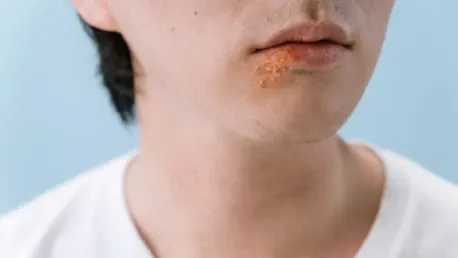In an era where medical science continually evolves, two pivotal areas of study are presenting groundbreaking findings likely to shape future therapeutic approaches. These research subjects delve into herpes simplex virus (HSV) mutations contributing to drug resistance and the intricate role of placental immune cells in shielding the fetus from various pathogens during pregnancy. The profound implications of these studies are not only fascinating but also crucial for developing novel treatment strategies.
Herpes Simplex Virus (HSV) and Drug Resistance
HSV, a highly prevalent virus, remains latent in nerve cells and can reactivate under triggers such as stress or sun exposure. Known for infecting over half the global population, HSV typically causes mild symptoms like occasional blisters or ulcers. However, a subset of the population experiences severe infections that resist conventional treatments with antivirals such as acyclovir and foscarnet. This resistance has propelled scientific investigations into the underlying mechanisms that allow the virus to escape these drugs’ effects.
Understanding HSV and Its Prevalence
HSV’s ability to stay dormant and reactivate makes it particularly challenging to treat. This virus can lie in wait within nerve cells for prolonged periods, only to flare up under various triggers. For many individuals, the resultant symptoms are relatively benign, but in some cases, the virus manifests more dangerously, defying conventional antiviral therapy and presenting a significant clinical challenge. A better understanding of HSV and its behavior is critical in formulating more effective treatments.
Investigating Resistance Mechanisms
Prompted by the need for more effective therapeutics, Jonathan Abraham’s team at Harvard Medical School embarked on an investigation into the resistance mechanisms of HSV using cryogenic electron microscopy (cryo-EM). The team’s focus was on HSV polymerase mutations that permit the virus to sidestep antiviral drugs, thereby obstructing DNA replication processes. This study involved examining the polymerase enzyme’s unique “hand-shaped” structure under different conditions, including exposure to antiviral agents. By analyzing the polymerase’s conformation changes, particularly between its “open” and “closed” positions, the team sought to elucidate how these mutations impart resistance.
The researchers discovered that resistance mutations primarily influence the dynamics of the polymerase, altering the movements of its “fingers” more than their direct interaction with drug-binding sites. This alteration allows the polymerase to continue functioning even in the presence of drugs designed to incapacitate it. Acyclovir works by mimicking nucleotides within the polymerase’s active site, forcing the enzyme into a closed state that halts DNA extension. Foscarnet behaves similarly, trapping the polymerase in a closed conformation and preventing viral replication. Mutations that enhance the movement of the polymerase’s “fingers” or diminish drug-binding affinity allow the virus to evade these drugs’ inhibitory effects.
Key Findings on Polymerase Dynamics
Key findings from the research provide a detailed account of how polymerase dynamics are altered by resistance mutations. The study revealed that HSV polymerase exists in multiple conformations, specifically transitioning between “open” and “closed” states. Resistance mutations don’t necessarily alter the enzyme’s structure directly but affect how its “fingers” move, thereby influencing its interaction with drugs. This mechanism allows HSV to continue replicating even in the presence of typically effective antiviral treatments.
The insights gleaned from this research are transformative in understanding HSV resistance. By determining that the movement dynamics of the polymerase are the primary factor in drug resistance, the study suggests potential pathways for developing new drugs. Future therapeutics could focus on stabilizing the HSV polymerase structure, preventing it from adopting the conformations that confer resistance.
Implications for Future Drug Development
The revelations about HSV polymerase dynamics have profound implications for future drug development. Jonathan Abraham’s assertions indicate that targeting the polymerase’s movement rather than its structure could be key in overcoming drug resistance. This paradigm shift could lead to the creation of novel antiviral drugs that can better stabilize the polymerase structure, rendering HSV susceptible once more to treatment.
IQ-IDM’s Adrian Wildfire emphasizes that understanding these dynamics is crucial for the development of next-generation antiviral therapies. By drawing parallels with advances made in treating other viral infections like HIV and SARS-CoV-2, Wildfire suggests that similar strides could soon be made against HSV. The ongoing research aims to exploit the newfound understanding of polymerase dynamics to counteract resistance effectively, ultimately improving patient outcomes through more targeted and efficient drugs.
Placental Immune Defense Against Pathogens
The placenta plays a vital role in protecting the developing fetus from infections, acting as a critical barrier and immune organ during pregnancy. Research into the placental immune system has traditionally relied heavily on mouse models, limiting the understanding of human-specific mechanisms. However, recent advancements by the Wellcome Sanger Institute have revolutionized this field, offering new insights and therapeutic possibilities.
The Role of the Placenta in Immune Defense
The placenta’s role in immune defense is essential for safeguarding the fetus from pathogens such as malaria and Listeria. The Wellcome Sanger Institute’s team, led by Roser Vento-Tormo, moved beyond traditional mouse models by employing human placental explants and single-cell RNA sequencing (scRNA-seq). This innovative approach has allowed for a detailed examination of the placental immune landscape, revealing critical players and mechanisms previously unappreciated in human pregnancy studies.
Hofbauer Cells and Their Immune Response
One of the study’s pivotal discoveries is the identification of Hofbauer cells (HBC) within the placenta as crucial immune defenders. Previously thought to be involved mainly in nutrient exchange, these macrophage-like cells play a significant role in responding to infections. HBCs react to pathogens like Plasmodium falciparum, the malaria-causing parasite, and Listeria monocytogenes by upregulating specific immune responses. For instance, in the presence of malaria, HBCs increase the expression of heme oxygenase-1 (HMOX1), whereas they upregulate toll-like receptor-2 in response to bacterial infections, showcasing their role in innate immunity.
These findings underscore the intricate nature of the placental immune system, highlighting its ability to detect and respond to various threats. By identifying and understanding these responses, researchers can better comprehend how infections during pregnancy affect both the mother and the fetus. Moreover, this knowledge opens the door to developing targeted therapies that can enhance or mimic these natural defense mechanisms, potentially providing protective benefits during pregnancy.
Potential Therapeutic Interventions
The study’s implications extend to developing therapeutic interventions aimed at mitigating the adverse effects of infections during pregnancy. By targeting the inflammatory pathways activated by HBCs, new treatments could potentially reduce infection-induced complications such as miscarriages and growth restrictions. Elias Ruiz-Morales, a graduate student and contributing author of the study, highlights the significance of addressing these complications to improve pregnancy outcomes.
Despite the promising findings, Deanne Taylor notes the challenge of maintaining explant viability for chronic condition studies. Extending the viability beyond the current 72-hour limit is essential for thoroughly understanding long-term placental responses. Future research endeavors will focus on overcoming this limitation, enabling more comprehensive studies that could further inform therapeutic strategies.
Therapeutic Advances in Periodontal Disease
Periodontal disease, characterized by inflammation leading to gum and bone loss, poses a significant health challenge. Innovative treatments are needed to address this debilitating condition, and recent research has shown promising directions. One such advancement stems from the University of Pittsburgh School of Dental Medicine, where a novel approach using microparticles loaded with the chemokine CCL2 has demonstrated encouraging results in promoting tissue repair and reducing inflammation.
Innovative Treatment for Periodontal Disease
Charles Sfeir and his team at the University of Pittsburgh have spearheaded a study exploring the therapeutic potential of CCL2-loaded microparticles. These microparticles are designed to stimulate an anti-inflammatory response, thereby promoting tissue repair in periodontal disease. The treatment was tested in a mouse model, and the results indicated significant improvements in bone preservation and tissue healing.
The therapy’s effectiveness lies in its ability to modulate the macrophage response, a critical component of the immune system involved in inflammation and tissue repair. By reducing the bacterial load indirectly through these immune mechanisms, CCL2 microparticles present a novel method for managing periodontal disease and improving oral health outcomes.
Efficacy of CCL2 Microparticles
The study’s findings show that administering CCL2 microparticles at various stages relative to disease onset can significantly reduce bone loss and promote tissue regeneration. This therapeutic approach leverages the body’s natural immune mechanisms, potentially offering a long-lasting solution to periodontal inflammation. As macrophages play a pivotal role in both bacterial clearance and tissue repair, the targeted action of CCL2 microparticles ensures a balanced and effective response.
The research also highlights the therapy’s ability to create a more favorable environment for tissue healing, reducing the need for more invasive treatments. By harnessing the anti-inflammatory properties of CCL2, the microparticles provide a dual benefit of immediate bacterial control and long-term tissue health, making it a compelling option for periodontal disease management.
Future Directions and Considerations
In today’s rapidly advancing field of medical science, two critical areas of research are making headway with findings poised to influence future treatment methodologies significantly. One focuses on the mutations of the herpes simplex virus (HSV) that contribute to drug resistance. This area of study is vital, as understanding these mutations can lead to more effective antiviral drugs, potentially reducing the prevalence and impact of drug-resistant HSV strains.
The second area of research explores the complex role of immune cells in the placenta, which play a crucial part in protecting the fetus from various pathogens during pregnancy. This study holds immense importance for prenatal health, as it could lead to new strategies for safeguarding unborn babies from infections that could lead to serious health issues.
The implications of these studies are far-reaching. On one hand, they offer hope for more effective treatments for HSV by tackling drug resistance head-on. On the other, they shed light on the natural defense mechanisms during pregnancy, providing insights that could enhance fetal protection and improve outcomes for millions of pregnancies. Thus, both research avenues are not only groundbreaking but also essential for advancing medical treatments and ensuring better health outcomes in the future.









